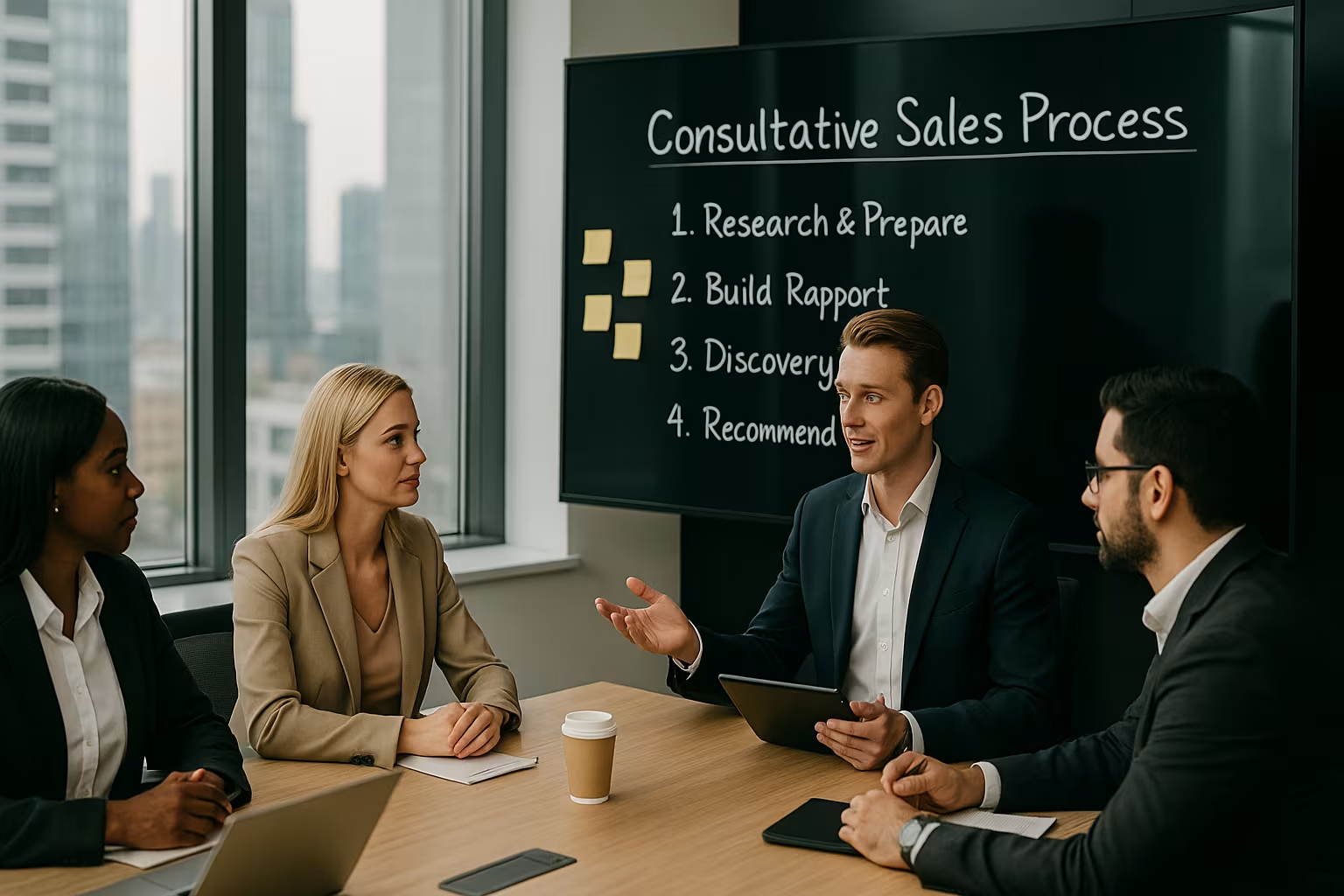
Lorem ipsum dolor sit amet, consectetur adipiscing elit. Suspendisse varius enim in eros elementum tristique. Duis cursus, mi quis viverra ornare, eros dolor interdum nulla, ut commodo diam libero vitae erat. Aenean faucibus nibh et justo cursus id rutrum lorem imperdiet. Nunc ut sem vitae risus tristique posuere.

October 13, 2025
Your prospects don’t want another pitch. They want perspective. If you still perceive sales as only the exchange of goods or services for money, then you’re holding your operations at risk, because your prospects don’t want a product; they want a partner.
That’s where the consultative sales process comes in. It’s not about pushing harder or talking faster. It’s about slowing down, listening deeper, and guiding smarter. The goal isn’t just to close more deals; it's to build relationships that convert again and again.
An affirmative consulting session can ensure a lifetime of revenue stream for your business. When you master this approach, you stop chasing sales and start attracting them.
At its core, the consultative sales process inverts the traditional model. Instead of leading with features, you lead with curiosity.
Instead of “Here’s what we offer,” it’s “Tell me what you need.”
A consultative selling approach means every interaction is a discovery, a deep dive into your prospect’s challenges, goals, and blind spots. You’re not selling to them; you’re collaborating with them.
As pointed out by experts, consultative sales is about identifying pain points, offering insights, and aligning your solution to real business outcomes, not just specs or discounts.
This method transforms you from a salesperson to a trusted advisor. And that’s the ultimate position of power in any market.
As businesses flourish through relationship management, one that addresses the needs of its consumers and provides accurate solutions is likely to be more successful compared to businesses in the same industry that focus solely on making a profit.
When you apply a consultative sales process, you:
Top-performing sellers now spend 57% more time researching and diagnosing than pitching (Gartner Research). Why? Because that’s where trust and credibility live.
The truth is simple: buyers buy from people who get them.
Here’s the framework that separates amateurs from advisors — your step-by-step roadmap to better conversions.
Let’s break them down.
Before you talk, study. The more you know, the more authority you project. Learn the company’s industry, size, goals, pain points, competitors, and trends.
A sales professional who shows up with context earns attention. One who wings it gets ghosted.
Your goal here isn’t just to impress; it’s to understand. Preparation allows you to tailor your questions, anticipate objections, and guide the conversation with precision.
Forget the forced small talk. Real rapport is built through authentic curiosity. Demonstrate genuine interest in their role, challenges, and goals.
People don’t buy from strangers. They buy from people who “get” them.
Mirror their energy, speak their language, and make the interaction feel like a partnership, not a sales pitch.
This is where your consultative skills truly shine. Discovery is about asking high-impact, open-ended questions that reveal why your prospect needs change, not just what they want to buy.
Examples:
These questions move the conversation from a surface level to a strategic one. You’re not chasing the sale, you’re diagnosing the truth.
Once you understand the problem, elevate the discussion. Share data, trends, or examples from similar clients. Help them see what they couldn’t see before.
This is called the “Insight Selling Advantage”, where sellers teach clients something new about their business.
This is your moment to guide, not pitch. When you educate, you add real value.
Now it’s time to collaborate. Present a tailored solution that reflects everything you’ve uncovered, their goals, constraints, and priorities.
Use visuals or frameworks to make it tangible. Involve them in building the solution, so they own it. That’s the psychological shift that turns a presentation into a partnership.
Remember: people don’t refuse what they help create.
Objections aren’t barriers; they’re opportunities. When prospects push back, it means they’re engaged.
A consultative seller doesn’t argue; they explore. Validate the concern (“That’s a fair question”), then reframe it with perspective.
For example:
“I understand the budget's tight, but let’s look at what it’s costing you not to act.”
When you handle objections with empathy and clarity, you turn hesitation into trust.
If you’ve done the previous steps right, the close feels natural. You’re not “asking for the sale”, you’re confirming the next step in a shared plan.
Be direct. Define the path: proposal, timeline, deliverables. Clarity eliminates friction.
This is where your professionalism seals the relationship.
Most salespeople focus on transactions, but the best focus on transformation.
The consultative sales process wins because it aligns with how people actually make decisions: emotionally first, logically second. It builds safety, clarity, and confidence.
When your clients feel heard and understood, price becomes secondary.
And here’s the kicker: once you master this, you won’t just convert better; you’ll retain longer, upsell easier, and attract higher-quality clients who trust you.
That’s the compounding effect of consultative selling.
Here’s what kills consultative selling before it starts:
Correct these, and your close rate will jump fast.
It’s one thing to understand the process. It’s another to make it part of your DNA.
Here’s how elite teams make consultative selling a habit, not a script:
Remember, structure creates consistency and consistency drives performance.
The consultative sales process isn’t a tactic; it’s a transformation. When you adopt this approach, you stop chasing deals and start designing outcomes. You become the go-to expert your clients rely on.
Prep harder, ask better questions. Share more profound insights and guide with confidence. Then watch what happens.
For weekly frameworks, stories, and behind-the-scenes tactics that top closers use every day, tune into the Pitch Me Podcast.
Because the truth is this:
You don’t need more leads, you need better conversations. And that starts right here.

Kayvon Kay
Kayvon has over two decades of experience working with high-level closers and perfecting his sales methodologies. He has earned the title of Canada’s #1 pharmaceutical sales representative and continues to share his expertise as a keynote speaker and through his multi-million-dollar coaching program.